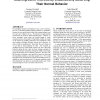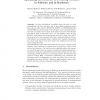210 search results - page 7 / 42 » Active learning for automatic classification of software beh... |
IUI
2000
ACM
13 years 11 months ago
2000
ACM
For intelligent interfaces attempting to learn a user’s interests, the cost of obtaining labeled training instances is prohibitive because the user must directly label each trai...
ACRI
2004
Springer
14 years 22 days ago
2004
Springer
We have investigated a problem where the goal is to find automatically the best rule for a cell in the cellular automata model. The cells are either of type OBSTACLE, EMPTY or CRE...
LREC
2010
13 years 8 months ago
2010
In the paper we investigate the impact of data size on a Word Sense Disambiguation task (WSD). We question the assumption that the knowledge acquisition bottleneck, which is known...
CHI
2009
ACM
14 years 2 months ago
2009
ACM
This paper aims to discuss the roles for the two types of tracking user behavior. Considering these two types of tracking, sensor based recognition has a great advantage when sens...
MM
2005
ACM
14 years 27 days ago
2005
ACM
The authors developed an extensible system for video exploitation that puts the user in control to better accommodate novel situations and source material. Visually dense displays...


